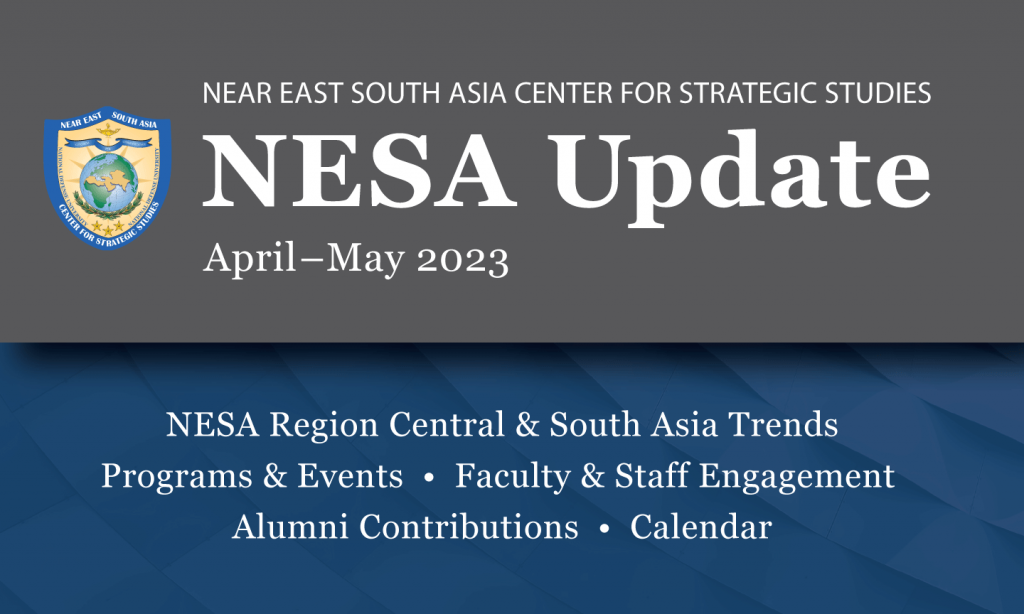April–May 2023 NESA Center Update Report
August 17, 2023 2023-08-17 8:57April–May 2023 NESA Center Update Report
April–May 2023 NESA Center Update Report
View the NESA Center April – May 2023 Update focused on Central and South Asia region trends. The update also highlights April through May NESA Center programs and events, faculty and staff engagements, alumni contributions, and a calendar with upcoming events.
Central & South Asia Trends:
-
A recent SIGAR report asserts that foreign armed groups and domestic security threats have increased in Afghanistan since the group took over the country in August 2021. The concern is also echoed in a UN Under-Secretary-General for Counterterrorism, Vladimir Voronkov’s statement, “Afghanistan has once again become a breeding ground for terrorism.” The UN statement comes after foreign ministers of the Moscow-led Collective Security Treaty Organization (CSTO) raised their concerns about the “deterioration” of the security situation in Afghanistan. In a statement, the ministers expressed their concern “over the deterioration of the security situation in Afghanistan and the invigorated activity of international terrorist organizations, primarily ISIS and its affiliate, Wilayat Khorasan.”
-
Russia has voiced similar concerns in recent weeks. Russian Foreign Ministry spokesperson was quoted that the Islamic State-Khorasan (Daesh) is seeking to undermine security and stability in Afghanistan and its neighboring countries, relying on external support.
-
An agreement between the Taliban government and Pakistan to relocate elements of Pakistani Taliban (TTP) in northern Afghanistan on the border with three central Asian states has alarmed the region about a new terrorism threat in the area. As terrorist attacks by the TPP in Pakistan significantly increased (73%), the Afghan regime announced a plan to relocate the TTP cadre from the Afghanistan-Pakistan border, the Durand Line, to northern and western provinces. The announcement has upset communities within Afghanistan and caused concerns in Central Asia. Some Afghans criticize the move believing that the objective is to transform northern Afghanistan into a new Waziristan, export terrorism and the transfer of terrorist groups to Central Asian countries, fuel proxy wars, and alter the demographic composition of the population.
-
Concerns over the Taliban-ruled Afghanistan becoming, again, a breeding ground for terrorism, worries nations across South and Central Asia. The concerns were reflected in several recent statements by the United Nations Security Council and leaders of Pakistan, Russia, and Central Asian states.
-
In May 2023, China hosted a conference for the Central Asian states in the city of Xi’an, outlining future paths between itself and the region. Throughout the summer, Central Asian reaction to this high-level event has been muted, with experts cautioning against agreements that would make the countries further indebted to China. As leaders and populations in the region are reconsidering their ties with Russia in light of the current war in Ukraine, they’re reluctant to find another dominant actor. To that end, regional connectivity is taking on a quality that includes multiple routes, a re-examination of the U.S. presence (primarily through the C5+1 format), and the rise of other external actors such as India and Turkiye. The latter country is especially important, given its role in the Organization of Turkic States (OTS), a structure that has held a number of high-level events this year and includes Azerbaijan, Uzbekistan, Kazakhstan, the Kyrgyz Republic, and Turkmenistan (as an observer).
-
There can be little doubt that U.S.-India cooperation has reached a new intensity, including in defense cooperation and critical technology. The announcement of INDUS-X on 21 June reveals the depth of progress made bilaterally on technological cooperation. INDUS-X, or India U.S. Defense Acceleration Ecosystem, is an incubator for greater cooperative effort.
-
Sri Lanka, despite its recent domestic turmoil, is garnering more international attention than ever before. Recent high-level visits by the French President and other senior state leaders indicate three overarching trends – that more non-South Asian states are recognizing the importance of a successful and stable Sri Lanka, that the eastern Indian Ocean is being recognized as more vital for strategic objectives (namely by European powers), and that there is an opportunity to gain mutually advantageous relations with a Sri Lankan regime no longer viewed as overtly pro-China.
Read the full NESA Update report [PDF]
Read other NESA Center reports here.








